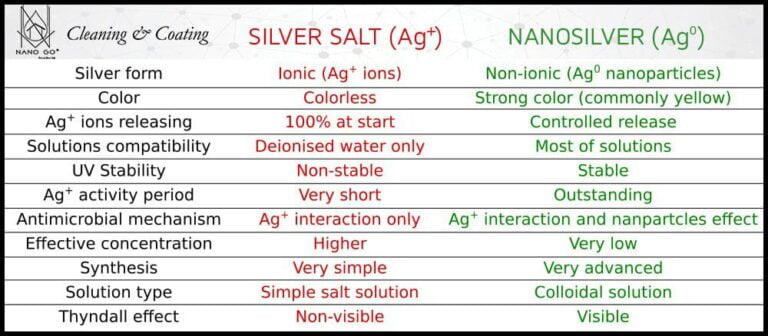NANOTECHNOLOGY | NANO GO® brings you into the world of Leading Innovation.
NANOSILVER FEATURES
Silver is a noble metal with strong antimicrobial qualities that have been known for a century. To avoid infections, early travellers and soldiers carried food and drink in silver vessels. The nanoparticle-based fragmentation of silver enhances its unique features and opens up new application areas.
Many NANOGO® products contain nanosilver (Ag) from 5ppm to 15ppm, which makes it safe to say that the antimicrobial efficacy of NANOGO® products is indisputable.
Microbes’ cells are easily penetrated by silver nanoparticles, severely damaging vital structures. Because of this, solutions containing nanosilver colloids (nanosilver suspension insolvent) can kill pathogens and prevent bacteria and other organisms from colonizing surfaces enhanced with nanosilver particles. In contrast to ionic solutions of silver salts, sometimes referred to as “dirty conditions,” where impurities lead to silver precipitation and significantly lower product activity, nanosilver suspensions are more active.
Metallic nanosilver doesn’t migrate from the structure of enhanced material and is resistant to UV radiation degradation (it doesn’t change colour in sunlight). The extraordinary antibacterial activity of nanosilver, which surpasses that of conventional antimicrobial agents, is the cause of the rising interest in nanosilver formula (silver works non-specific in opposition to, for instance, antibiotics which can be active for few microbes’ strains only). Demonstrates excellent durability and a low cost-to-effect ratio. For an average user, products enhanced with nanosilver will provide unexpected outcomes over time.
The utility of this finished product in everyone’s daily lives was identified by the nanosilver created at NANOGO partner laboratories. Numerous evaluations and tests have proven that our solutions produce outstanding outcomes.
For commercial applications, we provide nanosilver products in powder or colloidal suspension form. The diameter of nanoparticles is between 5 and 15 nm (usually 9 nm). As a result, our nanoparticles can thoroughly enhance the final product by completely penetrating the structure of the materials. A tiny component like this guarantees strong antimicrobial activity even at low concentrations.
NANO GO® | Leading innovations in your range

